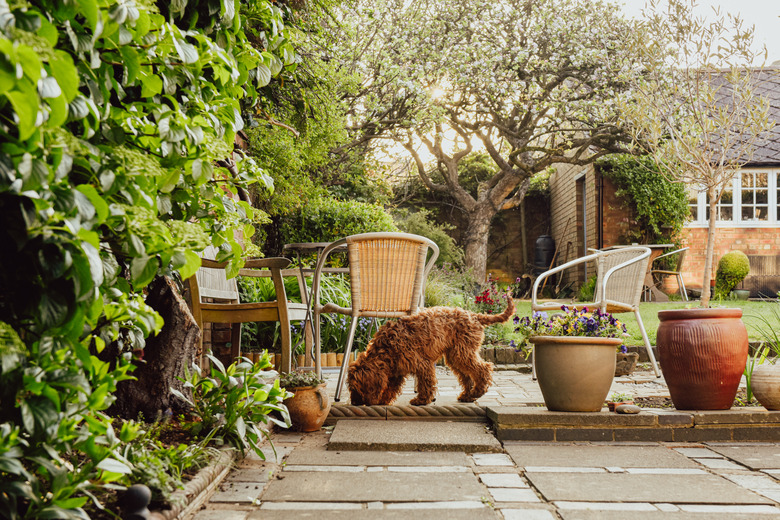5 Ways To Make Your Yard And Garden Fun For Your Dog
Are you looking for ways to make your backyard fun for your dog? If you're doing landscaping this summer, you might want to consider designing your yard to include dog-friendly enrichment as well as a garden area. Turning your yard into a sensory experience can take it from boring to enriching for your dog.
Building a sensory and dog-friendly garden
Building a sensory and dog-friendly garden
When thinking about turning your yard into more of a dog playground, consider the kinds of senses your dog has first. Find the ways that you can engage those senses in your yard design. Challenge yourself to make your yard as engaging as possible for your dog — by incorporating all of their senses. Here are some ideas:
Create foraging areas for your dog's sense of smell
Dogs experience so much of the world through their sense of smell. Try to create some foraging areas in your yard. The idea is to encourage your dog to sniff. These can be areas with tall, dog-safe grasses for your dog to explore. Or, they can be areas where you scatter treats and food to encourage your dog to spend time seeking and foraging for them.
Fill your yard with taste treats
Dogs love snacks! When planning your garden, consider plants that are safe for your dog to eat. From grass to vegetables, it's possible to fill your yard with treats that are dog friendly. Dog-safe vegetables such as Carrots, Green beans, and peas are all relatively easy to grow (in most climates) and are safe to share with your dog. You and your dog can snack on these veggies while out in the yard or, you can add them to your dog's meals for extra texture and flavor. Many dogs also enjoy munching on grass. Make sure that you avoid using any fertilizers or pesticides on your lawn — to keep the grass safe for your dog to snack on.
If you have a cat, consider planting catnip to bring indoors for your cat — to make your yard pet friendly for them.
Pay attention to what your dog enjoys hearing
Your yard is already full of interesting nature sounds for your dog. From the wind in the trees to the sounds of birds — and other neighborhood noises. Pay attention to what sounds seem to interest your dog the most while they are in your yard.
Digging and water games for touchpoints
Creating engaging areas of the yard for dogs to touch is a fun part of redesigning. When imagining touchpoints, think about the types of activities that your dog enjoys most. Does your dog like to dig? Instead of scolding your dog for digging in the garden, consider building a sandbox or purchasing one for them. You can shovel a hole in the ground and then add sand to it. Or, you can also use a baby pool and fill it with sand.
Provide your dog with a digging pit or an area of your yard where digging is not just allowed but encouraged. This can prevent them from digging in areas where you don't want it. When your dog's sandpit area is not in use, you'll want to consider covering it. This will prevent the area from becoming a litter box for wandering neighborhood cats.
If you have a dog who enjoys water games, you can also add a splash pad or baby wading pool during the warm weather. If you have a water-loving dog and want to go all out, you can even purchase an above-ground pool. You can build stairs and an interior dog platform so your dog can swim and get in and out of the pool on their own. For safety, be sure to supervise your dog anytime they are in or near the pool.
Create wildlife areas for your dog's sense of sight
Does your dog like to watch the birds and squirrels? Create wildlife-friendly areas of your garden that your dog can watch from the window or while lounging outside. Bird feeders and birdbaths are a great way to encourage birds to spend time in your yard. Though if you have a dog who chases or is a risk to wildlife, be thoughtful about not encouraging wildlife to spend time in the areas of the yard where your dog might be able to access them.
Dog-friendly yards and safety
Dog-friendly yards and safety
Even if you aren't going to turn your yard into a full sensory experience for your dog, the first step of prioritizing your dog in the yard design is their safety first and foremost. Scoop poop in the yard daily. You'll want to make sure that you have secure fencing appropriate for your dog's size. Also, ensure that there isn't anything dangerous that could harm your dog while they are playing.
Select plants that are safe for your dog — this is important regardless. The ASPCA toxic and nontoxic plant list is a great resource to consult when purchasing new plants, and for evaluating what plants are already growing in your yard.
In summary
In summary
You don't have to have a huge yard to give your dog enriching sensory experiences. Consider how you can create more sensory-enriching activities and spaces for your dog — in whatever outdoor space you have. When designing your yard, think about how you can engage all of your dog's senses, while also prioritizing their safety. Build on your dog's natural curiosity, and find ways to encourage them to play and explore the yard environment.



